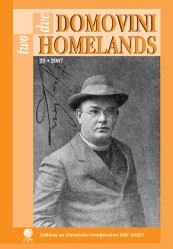Tih opazovalec v nemem prostoru: etnografija danes
Ključne besede:
etnografija, metodologija, drugačnost, reprezentacije, avtentičnostPovzetek
Etnografija kot metodološka disciplina se danes srečuje z mnogimi spremembami v antropologiji in sociologiji, v mobilnosti in gibanju, v čez-kulturnih in transnacionalnih vezeh itn. Na etnografe čaka vse bolj mešan svet kulturnih elementov. V antropologiji je bila nedefinirana pozicija raziskovalcev znotraj družbenih procesov vselej pomemben del metodoloških razprav. Kontekstualne in demografske spremembe znotraj discipline postavljajo zdaj v ospredje tudi nova identitetna vprašanja pri samih antropologih in njihovega odnosa do tistih, ki jih proučujejo ali tistega, kar raziskujejo. Čeprav upravičenost in korist več-prostorske etnografije danes skoraj že več ni vprašljiva, se še vedno pojavljajo težave pri tem, kako naj bi etnografijo pravzaprav izvajali. Kot pravi Susanne Friedberg, te težave postavljajo v disciplino »večje ali manjše prepreke, ki so odvisne od obsega projekta in časa, ki je namenjen zanj, od finančnih ter drugih razpoložljivih sredstev« (Friedberg, 2001: 362-363). Ne samo cilji, tudi značaj multi-lokalne ali trans-lokalne (Hannerz, 2003) etnografije spreminja podobo discipline. Kljub temu, da je za antropologe že od vsega začetka bilo značilno, da dvomijo in da v svojem delu potujejo onkraj kontekstualnega okvirja ter da so vselej blizu vsem vrstam meja, trenutne spremembe postavljajo v ospredje raziskav nova epistemološka vprašanja in nove etične dileme. Ne le prostori, ampak tudi ljudje lahko postanejo manj pomembni v etnografskem raziskovanju. Širjenje geografskega prostora še ne prinese sprememb v reprezentacijah tega prostora. V kontekstu antropološkega standarda, ki se skozi čas ni posebej spreminjal, avtorica v članku uporablja pojem »drugačenja« in »utišanja« in s tem razlaga nekatere temeljne načine, ki jih etnografi uporabljajo za reprezentacijo drugih kultur in drugih ljudi. Avtorica govori tudi o pojmu prepoznavanja, še posebej v navezavi na politiko prepoznavanja, ter razpravlja o konceptu avtentičnosti, ki se razvije iz politike prepoznavanja. Pozicijo etnografov in njihovih raziskovalnih polj avtorica navezuje na konstrukcijo odnosa med subjektom in objektom. Obenem raziskuje naravo etnografskega odnosa do prostorov raziskovanja in razlaga idejo o »biti tam… tam… in tam«, ki je geografsko pogojena in upravičuje avtoritarno pozicijo raziskovalca v globaliziranem svetu. Čeprav je bilo etnografsko prakso vselej težko zamejiti, pa lahko rečemo, da se je etnografija v zadnjih desetletjih soočila z nekaterimi pomembnejšimi spremembami. Za etnografijo danes ni značilno le premikanje raziskovalca iz enega fiksnega prostora v drugega. Čeprav se etnograf morda v fizičnem smislu sploh ne premika, še vedno potuje. Premikanje čez ne-fizične, domišljijske svetove postaja tudi v etnografiji danes vse bolj pomembno.
Prenosi
Literatura
Abu-Lughod, Lila (2000). Locating ethnography. Ethnography, Vol. 1, No. 2, pp. 261–267.
Benhabib, Seyla (2002). The Claims of Culture. Equality and diversity in the global era. Princeton, Oxford: Princeton University Press.
Clifford, James (1988). The Predicament of Culture: Twentieth-Century Ethnography, Literature, and Art. Cambridge: Harvard UP.
Coffey, Amanda (1999). The Ethnographic Self. Fieldwork and the Representation of Identity. London: SAGE.
De Beistegui, Miguel (1998). Heidegger and the political. Dystopias. London, New York: Routledge.
Freidberg, Susanne (2001). On the trail of the global green bean: methodological considerations in multi-site ethnography. Global Networks, Vol. 1, No. 4, pp. 353–368.
Gottlieb, Alma; Graham, Philip (1999). Revising the Text, Revisioning the Field: Reciprocity over the Long Term. Anthropology and Humanism, Vol. 24, No. 2, pp. 117–128.
Hannerz, Ulf (2003). Being there… and there… and there!: Reflections on Multi-Site Ethnography. Ethnography, Vol. 4, No. 2, pp- 201–216.
Gunew, Sneja (2004). Haunted Nations. The Colonial dimensions of multiculturalisms, Routledge: London.
Hallam, Elizabeth; Street, Brian V. (eds.) (2002). Cultural encounters. Representing “otherness”. London, New York: Routledge.
Heidegger, Martin (1962). Being and Time, NY: Harper and Row.
Jirousek, Lori (2006). Ethnics and Ethnographers: Zora Neale Hurston and Anzia Yezierska, Journal of Modern Literature, Vol. 29, No. 2, pp.19–32.
Lee, R.M. (2000). Unobtrusive Methods in Social Research. Buckingham: Open University Press.
Lau, Evelyn (1995). Other Women: A Novel, Toronto: Random House of Canada.
Marcus, G. (1998). Ethnography Through Thick and Thin. Princeton NJ: Princeton University Press.
Metcalf, Peter (2005). Anthropology: The Basics. London: Routledge.
Pauwels, Luc (2005). Websites as visual and multimodal cultural expressions: opportunities and issues of online hybrid media research. Media, Culture & Society, Vol. 27, No. 4, pp. 604–613.
Perish, Tim and Nicholas Low (2006). Nomadology. Undergrowth Magazine #7.
Said, Edward W. (1978). Orientalism, NY: Pantheon Books.
Sillitoe, Paul (2007). Anthropologists only need apply: challenges of applied anthropology. Journal of the Royal Anthropological Institute, 13, pp. 147–165.
Taylor, Charles (1992a). Multiculturalism and the Politics of Recognition. Princeton, NJ: Princeton University Press.
Taylor, Charles (1992b). The Ethics of Authenticity. Cambridge and London: Harvard University Press.
Wilding, Raelene (2007). Transnational Ethnographies and Anthropological Imaginings of Migrancy. Journal of Ethnic and Migration Studies, Vol. 33, No. 2, pp. 331–348.
Žižek, Slavoj (1996). “I Hear You With My Eyes”: or, the Invisible Master, in (eds) Sic 1: Gaze and Voice as Love Objects, (eds. R. Salecl and S. Žižek), Durham, NC: Duke University Press.
Prenosi
Objavljeno
Kako citirati
Številka
Rubrike
Licenca

To delo je licencirano pod Creative Commons Priznanje avtorstva-Nekomercialno-Brez predelav 4.0 mednarodno licenco.
Avtorji jamčijo, da je delo njihova avtorska stvaritev, da v njem niso kršene avtorske pravice tretjih oseb ali kake druge pravice. V primeru zahtevkov tretjih oseb se avtorji zavezujejo, da bodo varovali interese založnika ter da bodo povrnili morebitno škodo.
Podrobneje v rubriki: Prispevki





